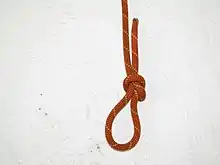Noose
A noose is a loop at the end of a rope in which the knot tightens under load and can be loosened without untying the knot. The knot can be used to secure a rope to a post, pole, or animal but only where the end is in a position that the loop can be passed over.
| Noose | |
|---|---|
 A noose knot tied in kernmantle rope | |
| Names | Noose, running knot |
| Category | Loop |
| Related | Slip knot, hangman's knot, running bowline, arbor knot |
| Releasing | Non-jamming |
| Typical use | Animal snares, knitting, self tightening end loop |
| ABoK | #1114,[1] #1803, #1789, #8, #43, #1825 |
Tying
The knot is tied by forming a loop in the end of a rope, and then passing a bight of the standing end through the loop. The noose knot is a slipped version of the overhand knot.
Use in hanging
The knot most closely associated with execution is the hangman's knot, which is also known as the "hangman's noose." Tying is similar to the original noose, but several turns are wrapped around the loop. The reason for this was to make the hanging more humane, as it would break the person's neck, killing the person instantly, rather than strangling to death.
Use in intimidation and hate-based racial politics
In the United States, a noose is sometimes left as a message in order to intimidate people, as it was the main object used in segregation era lynchings.[2][3] In 2020, a bill to make lynching a federal hate crime was introduced.[4] It is illegal to display a noose in a threatening manner in Virginia,[5] New York and Connecticut.[6]
Austin Reed Edenfield, a former student of the University of Mississippi, pled guilty in 2016 to a federal civil-rights crime, acknowledging that he and another man had tied a noose and a Confederate flag around the neck of a statue honoring James Meredith, the university's first African-American student.[7] In September of 2019, Andrew M. Smith, a University of Illinois student, was arrested for placing a noose in a campus elevator. "The incident comes just months after black employees filed a class-action lawsuit against the campus, alleging they faced racial harassment and were exposed to threats of racial violence, such as nooses, swastikas, KKK garb, racist graffiti, and confederate flags."[8]
Further reading
- Jack Shuler, The Thirteenth Turn: A History of the Noose, Public Affairs, 2014, ISBN 9781610391368
References
- Ashley, Clifford W. (1993) [1944], The Ashley Book of Knots, New York: Doubleday, p. 204, ISBN 0-385-04025-3
- Noose incidents evoke segregation-era fears, NBC News. October 10, 2007.
- Coast Guard tries to deal with noose incidents, CNN. October 4, 2007.
- https://www.nytimes.com/2020/02/26/us/politics/anti-lynching-bill.html
- Displaying noose on property of another or a highway or other public place with intent to intimidate; penalty, Code of Virginia. October 27, 2017.
- Noose displays provoke new state penalties, Stateline.org. June 6, 2008.
- Svrluga, Susan (March 24, 2016). "Former Ole Miss student pleads guilty to hanging noose around statue honoring the first black student". Washington Post.
- Melendez, Pilar (September 3, 2019). "University of Illinois Student Charged With Hate Crime After Noose Found Hanging in Dorm Elevator: Officials". Daily Beast.